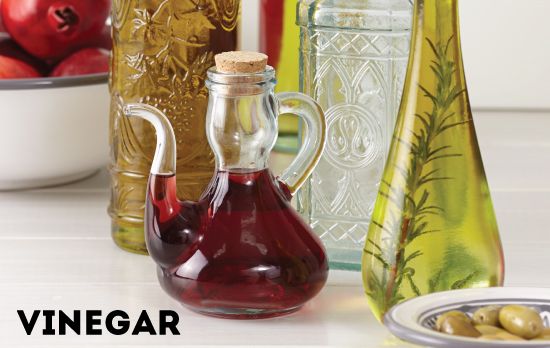Seasoning School - Vinegar
 |
| Vinegar tends to get overlooked as a seasoning. But it can be a wonderful addition to many dishes, as long as you use it carefully. Most importantly, you don’t want to taste the vinegar. Like salt, its function is to build the flavours within a dish. |
Cooking Tips• Adding vinegar to the water when poaching eggs helps the whites keep their shape.• To make perfect fluffy meringue, add a teaspoon of vinegar to every three egg whites. • A teaspoon of red or white wine vinegar brings out the flavours in a sauce for almost any casserole. • When cooking rice, add a dash of vinegar. • A dash of vinegar in a chocolate cake helps keep it moist. • Many types of vinegar work with sweet things as well as savoury – for example, balsamic vinegar is brilliant with strawberries |
Types of VinegarDifferent vinegars pair well with different oils. For example, sherry vinegar goes well with nut oils such as hazelnut. Red wine vinegar is great in cooking, and many vinegars work well in marinades before grilling or frying meats – they break down the connective tissue and tenderise the meat, while also adding flavour by absorbing the tastes of herbs and spices used in the marinade. Here are a few popular vinegars. |
| Red wine vinegar Made from red grapes, red wine vinegar is a good base for a vinaigrette. It’s also the best type of vinegar for deglazing a pan when you’re cooking red meat or pork. White wine vinegar Usually made from white grapes, but sometimes from red, white wine vinegar is suited to sauces such as hollandaise, where it helps break the other ingredients down. It also makes a delicious salad dressing. Cider vinegar Amber in colour, due to being made from fermented apples, cider vinegar is one of the most versatile. It accompanies salads well, and is often an ingredient in dressings, chutneys and other preserves. Balsamic vinegar Balsamic vinegar is made by cooking and concentrating the juice of white Trebbiano grapes. Genuine, traditional balsamic vinegar comes from Modena or Reggio Emilia in Italy, and must be aged for at least ten years. It has a distinctive, velvety full flavour that combines the taste of sweet and sour perfectly. A more common balsamic vinegar, often called ‘aceto balsamico’, can be mass-produced with caramelised sugar added to the grapes. It has a sweet vinegary taste, very different from the traditional product, but possesses a similar dark colour. Asian vinegars Originating from China and Japan, Asian vinegars are the product of fermented rice. Brown rice vinegar is more popular in Japanese cuisine, especially for preparing sushi, and white rice vinegar is more common in Chinese dishes. Chinese rice vinegar is traditionally used in stir-frys, because it’s more acidic than Japanese rice vinegar. There’s also black rice vinegar, which is dark brown and inky in colour, and traditionally used to season meats. Flavoured vinegars Flavoured vinegars or fruit vinegars are a modern twist on the classic cooking vinegars, and used mainly for dressing or accompanying a dish rather than in the actual culinary process. For example, passion fruit vinegar is used to accompany salad or even as a dressing on seafood because of its tropical taste, giving a bland dish a much-needed kick. Flavoured vinegars usually use white wine vinegar as a base and then equal amounts of fruit, which is eventually boiled and reduced. Sherry vinegar A gourmet vinegar traditionally made from the wine of Palomino grapes, sherry vinegar has a deep, complex flavour. It’s often used to add character to rich, tasty dishes such as soups and casseroles. |

